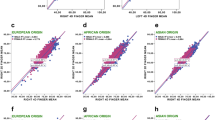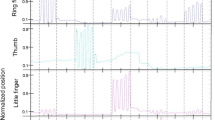Abstract
The ratio of 2nd and 4th digit length (2D:4D) is sexually dimorphic and may be a correlate of prenatal sex steroids. 2D:4D is often calculated from measurements of photocopies of fingers. However, 2D:4D from photocopies is lower than 2D:4D from direct measurements of the fingers. A new and promising source of 2D:4D measures is self-reports from Internet studies. This necessitates self-report of direct finger measurements and such measurements may be unreliable. In the present study, we compared 2D:4D from self-reported finger lengths measured directly from the fingers (S-R 2D:4D) and experimenter-measured finger lengths from photocopies of the fingers (photo 2D:4D). There were 329 participants (77 men, 252 women) recruited from a first-year undergraduate psychology pool. Compared to photo 2D:4D, (1) S-R 2D:4D tended to include some extreme values; (2) S-R 2D:4D was higher; (3) S-R 2D:4D showed weak similarities which increased when extreme values of S-R 2D:4D were removed; (4) photo 2D:4D and S-R 2D:4D showed lower values for males compared to females but the dimorphism was significant for the former but not for the latter. We conclude that, insofar as S-R 2D:4D has similarities to 2D:4D from Internet studies, the 2D:4D from Internet studies will show extreme values which should be removed, mean 2D:4D will be higher than from photocopy studies, and the sexual dimorphism will be weaker than in photo 2D:4D. We suggest that large samples are necessary in Internet studies of 2D:4D because measurement error will reduce effect sizes.


Similar content being viewed by others
References
Blanchard, R., & Ellis, L. (2001). Birth weight, sexual orientation and the sex of preceding siblings. Journal of Biosocial Science, 33, 451–467.
Blanchard, R., Zucker, K. J., Cavacas, A., Allin, S., Bradley, S. J., & Schachter, D. C. (2002). Fraternal birth order and birth weight in probably prehomosexual feminine boys. Hormones and Behavior, 41, 321–327.
Gosling, S. D., Vazire, S., Srivastava, S., & John, O. P. (2004). Should we trust web-based studies? A comparative analysis of six preconceptions about internet questionnaires. American Psychologist, 59, 93–104.
Malas, A. M., Dogan, S., Evcil, E. H., & Desdicioglu, K. (2006). Fetal development of the hand, digits and digit ratio (2D:4D). Early Human Development, 82, 469–475.
Manning, J. T. (2002). Digit ratio: A pointer to fertility, behavior and health. New Brunswick, NJ: Rutgers University Press.
Manning, J. T., Churchill, A. J. G., & Peters, M. (2007). The effects of sex, ethnicity, and sexual orientation on self-measured digit ratio (2D:4D). Archives of Sexual Behavior, 36, 223–233.
Manning, J. T., Fink, B., Neave, N., & Caswell, N. (2005). Photocopies yield lower digit ratios (2D:4D) than direct finger measurements. Archives of Sexual Behavior, 34, 329–333.
Manning, J. T., Scutt, D., Wilson, J., & Lewis-Jones, D. I. (1998). The ratio of 2nd to 4th digit length: A predictor of sperm numbers and concentrations of testosterone, luteinizing hormone and oestrogen. Human Reproduction, 13, 3000–3003.
Manning, J. T., Stewart, A., Bundred, P. E., & Trivers, R. L. (2004). Sex and ethnic differences in 2nd to 4th digit ratio of children. Early Human Development, 80, 161–168.
Manning, J. T., & Taylor, R. P. (2001). Second to fourth digit ratio and male ability in sport: Implications for sexual selection in humans. Evolution and Human Behavior, 22, 61–69.
McFadden, D., Loehlin, J. C., Breedlove, S. M., Lippa, R. A., Manning, J. T., & Rahman, Q. (2005). A reanalysis of five studies on sexual orientation and the relative length of the 2nd and 4th fingers (the 2D:4D ratio). Archives of Sexual Behavior, 34, 341–356.
McIntyre, M. H., Ellison, P. T., Lieberman, D. E., Demerath, E., & Towne, B. (2005). The development of sex differences in digital formula from infancy in the Fels Longitudinal Study. Proceedings of Royal Society London B, 272, 1473–1479.
Reimers, S. (2007). The BBC Internet Study: General methodology. Archives of Sexual Behavior, 36, 147–161.
Schneider, H. J., Pickel, J., & Stalla, G. K. (2006). Typical female 2nd–4th finger length (2D:4D) ratios in male-to-female transsexuals - possible implications for prenatal androgen exposure. Psychoneuroendocrinology, 31, 265–269.
Trivers, R., Manning, J. T., Jacobson, A. (2006). A longitudinal study of digit ratio (2D:4D) and other finger ratios in Jamaican children. Hormones and Behavior, 49, 150–156.
Author information
Authors and Affiliations
Corresponding author
Rights and permissions
About this article
Cite this article
Caswell, N., Manning, J.T. A Comparison of Finger 2D:4D by Self-Report Direct Measurement and Experimenter Measurement from Photocopy: Methodological Issues. Arch Sex Behav 38, 143–148 (2009). https://doi.org/10.1007/s10508-007-9202-3
Received:
Revised:
Accepted:
Published:
Issue Date:
DOI: https://doi.org/10.1007/s10508-007-9202-3




